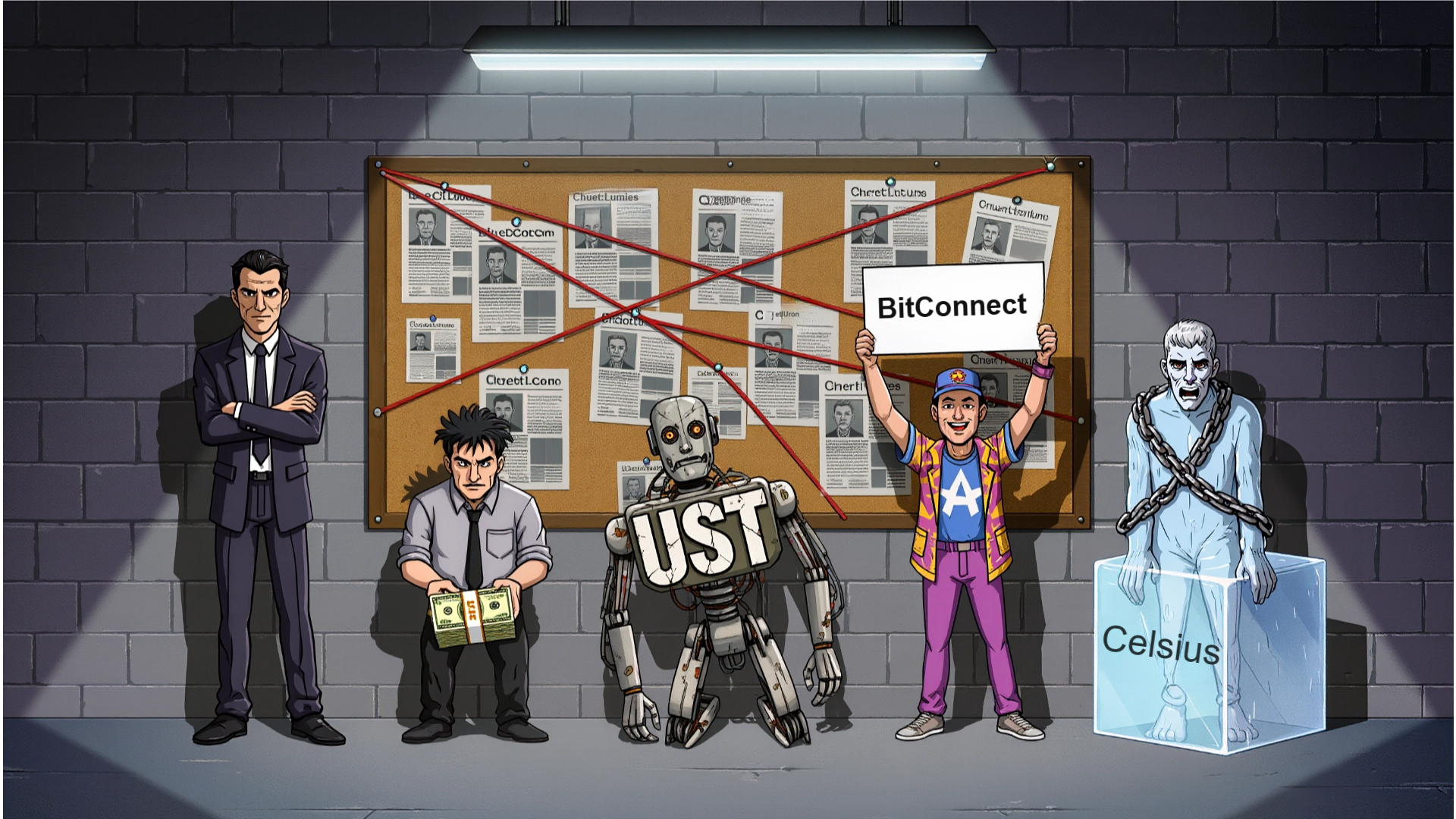You know, when my son first told me about Bitcoin, my immediate thought was “this sounds like something Bernie Madoff would have invented in his garage.” And honestly? I wasn’t entirely wrong to be suspicious. But here’s the thing: just because scams exist in cryptocurrency doesn’t mean cryptocurrency itself is a scam – any more than the existence of counterfeit dollars makes the U.S. dollar illegitimate.
Hello again, folks. Walter here, and today we’re going to talk about something that makes even crypto enthusiasts uncomfortable: scams. Big ones. The kind that make traditional bank heists look like someone stealing loose change from a car’s cup holder.
Let’s Address the Elephant in the Digital Room
Yes, the cryptocurrency world has been absolutely plagued with scams, frauds, and schemes that would make even the slickest snake oil salesman blush. The combination of new technology, limited regulation, and the promise of overnight riches created a perfect storm for con artists. It’s like the Wild West, except instead of stagecoach robberies, we have people stealing billions with a few lines of computer code.
Here’s what I need you to understand: The prevalence of scams in crypto doesn’t necessarily mean the entire concept is fraudulent. Remember when email was new? Suddenly we had Nigerian prince scams everywhere. Did that make email itself a scam? Of course not. But it did mean we all had to learn to be more careful about what we clicked.
Is Bitcoin Itself a Scam? The Jury’s Still Out
Now, whether Bitcoin itself is some elaborate long-con is still a matter of debate. But healthy scepticism? That’s always appropriate. Especially when you see what some people have done using the idea of cryptocurrency to separate honest folks from their hard-earned money.
Walter’s Top 5 Crypto Scams: The Wanted List
Let me walk you through five of the most spectacular frauds in cryptocurrency history. I’m presenting these in police “crime sheet” format – because honestly, these stories read like the plot of a crime thriller, except they’re all terrifyingly real.
CASE FILE #1: “THE CRYPTOQUEEN”
CASE FILE: OneCoin
ALLEGED PERPETRATOR: Ruja Ignatova (aka “The Cryptoqueen”)
AMOUNT STOLEN: $4-5 billion
STATUS: Still at large – FBI Ten Most Wanted Fugitive
REWARD: $5 million
THE CRIME:
From 2014 to 2017, Dr. Ruja Ignatova orchestrated what may be the largest cryptocurrency fraud in history. OneCoin claimed to be a revolutionary cryptocurrency that would surpass Bitcoin. The problem? There was no actual cryptocurrency. It was smoke and mirrors wrapped in fancy marketing materials and slick presentations at luxury venues worldwide.
HOW IT WORKED:
OneCoin was a classic Ponzi scheme disguised as a cryptocurrency. Investors bought “educational packages” that supposedly included OneCoin tokens. They were promised these tokens would skyrocket in value. Early investors were paid returns from new investors’ money – the oldest scam in the book, just dressed up in blockchain buzzwords.
The operation had all the hallmarks of a cult: lavish events, charismatic leadership, and promises of unimaginable wealth. Dr. Ruja traveled the world in private jets, spoke to packed auditoriums, and convinced hundreds of thousands of people across 175 countries that they were getting in on the ground floor of the next Bitcoin.
THE BUST:
In 2017, just as U.S. authorities were closing in, Ignatova boarded a plane from Sofia, Bulgaria to Athens, Greece – and vanished. She hasn’t been seen since. In June 2022, she was added to the FBI’s Ten Most Wanted Fugitives list, making her the only woman currently on that list.
Her brother and co-founder, Konstantin Ignatov, was arrested and eventually cooperated with authorities. He was sentenced to time served and probation. OneCoin’s lawyer, Mark Scott, was sentenced to 20 years in prison for laundering $400 million of the stolen funds.
VICTIM RECOVERY:
Minimal to none. Most victims have recovered little to nothing. The money has been laundered through complex international transactions, and with the mastermind still missing, there’s little hope of significant restitution.
WALTER’S TAKE:
The OneCoin case perfectly illustrates why due diligence matters. If something promises Bitcoin-level returns without actually having blockchain technology that can be independently verified, run – don’t walk – in the other direction. The fact that Dr. Ruja remains free somewhere in the world (possibly with a new face, according to some theories) is both fascinating and terrifying.
CASE FILE #2: “THE CRYPTO KING”
CASE FILE: FTX Exchange
ALLEGED PERPETRATOR: Sam Bankman-Fried (aka “SBF”)
AMOUNT STOLEN: $8 billion
STATUS: Convicted – Sentenced to 25 years in federal prison
RESTITUTION: Ordered to forfeit $11 billion
THE CRIME:
This one stings because FTX was supposed to be one of the “good guys.” Sam Bankman-Fried cultivated an image as the responsible adult in the crypto room – testifying before Congress, pledging to donate his wealth, living frugally in the Bahamas (okay, that part was always suspicious). Behind the scenes, he was running FTX like his personal piggy bank.
HOW IT WORKED:
FTX was a legitimate cryptocurrency exchange – until it wasn’t. Bankman-Fried secretly funneled customer deposits to his trading firm, Alameda Research, where the money was used for risky investments, political donations, real estate purchases, and venture capital investments. When crypto prices crashed in 2022, there was a massive hole in FTX’s balance sheet. When customers tried to withdraw their money, it simply wasn’t there.
It was the classic “borrow from Peter to pay Paul” scheme, except Peter was millions of customers who thought their money was sitting safely in FTX accounts.
THE BUST:
In November 2022, investigative reporting revealed the depth of the fraud, triggering a bank run. FTX collapsed in days. Bankman-Fried was arrested in the Bahamas in December 2022 and extradited to the U.S. After a month-long trial, he was convicted on seven counts of fraud and conspiracy in November 2023.
THE SENTENCE:
In March 2024, Judge Lewis Kaplan sentenced Bankman-Fried to 25 years in prison, calling his crimes “extraordinary” and noting his lack of genuine remorse. He was also ordered to forfeit $11 billion.
VICTIM RECOVERY:
Here’s where it gets interesting. FTX’s bankruptcy estate has recovered enough assets that customers may actually get most of their money back – though valued at 2022 prices, meaning they’ll miss out on any gains Bitcoin has made since then. The bankruptcy is expected to return somewhere between 90-118% of customer claims.
WALTER’S TAKE:
The FTX collapse proves that even “regulated” exchanges with celebrity endorsements and Congressional testimonies can be fraudulent. The lesson here isn’t “don’t use exchanges” – it’s “don’t keep all your crypto on an exchange, and remember that impressive credentials don’t equal trustworthiness.” Bernie Madoff sat on boards and had impeccable credentials too.
CASE FILE #3: “THE ALGORITHMIC DISASTER”
CASE FILE: Terra Luna / UST Collapse
ALLEGED PERPETRATOR: Do Kwon (Terraform Labs founder)
AMOUNT STOLEN: $40 billion in market losses
STATUS: Pleaded guilty August 2025 – Awaiting sentencing
RESTITUTION: Unlikely – money evaporated rather than stolen in traditional sense
THE CRIME:
Do Kwon created an “algorithmic stablecoin” called UST (TerraUSD) that was supposed to maintain a $1 value through complex mechanisms involving its sister token, Luna. He promised 20% yields to depositors through a protocol called Anchor. It was financial engineering held together with hope and hubris.
HOW IT WORKED:
The system relied on people’s faith that UST would maintain its $1 peg. When that faith wavered in May 2022, the entire house of cards collapsed in what’s called a “death spiral.” As UST lost its peg, Luna was minted to try to restore it, but this just created more Luna tokens, diluting the value. Luna went from $80 to fractions of a cent in days. UST went from $1 to pennies. Approximately $40 billion in value vanished.
Was it intentionally fraudulent from the start, or a well-intentioned but catastrophically flawed design? Prosecutors believe it was fraud. Do Kwon knew the system was unsustainable but promoted it anyway.
THE BUST:
After the collapse, Do Kwon fled to Singapore, then Serbia, then Montenegro, where he was arrested in March 2023 using a fake passport. After months of legal battles over extradition to either the U.S. or South Korea, he was extradited to the U.S. in early 2025.
On August 12, 2025, Do Kwon pleaded guilty to one count of conspiracy to defraud and one count of wire fraud.
VICTIM RECOVERY:
Essentially zero. When a token goes from $80 to $0.00001, there’s nothing left to recover. Unlike traditional fraud where money is stolen and hidden, this was wealth destruction on a massive scale.
WALTER’S TAKE:
The Terra Luna collapse is different from traditional scams – it shows how financial engineering can create systemic risk that wipes out billions almost instantly. The promise of 20% returns in a zero-interest-rate environment should have been a giant red flag. In finance, if something seems too good to be true and you can’t understand how it works, it probably is too good to be true.
CASE FILE #4: “BITCONNNNNNECT!”
CASE FILE: BitConnect
ALLEGED PERPETRATOR: Satish Kumbhani (founder)
AMOUNT STOLEN: $2.4 billion
STATUS: Indicted but remains fugitive; top promoter Glenn Arcaro sentenced to prison
RESTITUTION: Victims recovering approximately $17 million of $2.4 billion lost
THE CRIME:
BitConnect promised investors returns of up to 1% per day through a “trading bot” and “volatility software” that supposedly profited from Bitcoin price swings. It was a classic Ponzi scheme with crypto characteristics, complete with a pyramid-style referral program that turned victims into recruiters.
HOW IT WORKED:
Investors would lend their Bitcoin to BitConnect in exchange for “BCC” tokens. These tokens supposedly earned guaranteed daily returns. New investors’ money paid earlier investors’ returns – the definition of a Ponzi scheme. The whole operation was wrapped in technical jargon and promoted through social media and YouTube by an army of affiliates who earned commissions for recruiting new victims.
The scheme became infamous for its promotional events, particularly one where a top promoter screamed “BITCONNNNNNECT!” to a cheering crowd – a moment that became a meme and symbol of crypto excess.
THE BUST:
In January 2018, BitConnect abruptly shut down after receiving cease-and-desist letters from Texas and North Carolina securities regulators. The BCC token immediately plummeted from $370 to under $1.
Satish Kumbhani was indicted by U.S. authorities in 2022 but remains at large. Glenn Arcaro, the top U.S. promoter, pleaded guilty to fraud charges and was sentenced to prison. He agreed to forfeit $56 million.
Indian authorities seized approximately $190 million in cryptocurrency related to the scam in 2024.
VICTIM RECOVERY:
Abysmal. Glenn Arcaro was ordered to pay $17 million in restitution to victims – a tiny fraction of the $2.4 billion lost. Most victims recovered nothing.
WALTER’S TAKE:
BitConnect is the poster child for “if it sounds too good to be true, it is.” Guaranteed daily returns of 1%? That’s 365% annually – or more with compounding. If such a trading algorithm existed, they wouldn’t need your money; they’d be using it themselves. The pyramid recruitment structure should have been another massive red flag. Sadly, greed clouds judgment, and thousands of people learned expensive lessons.
CASE FILE #5: “THE CRYPTO LENDING CATASTROPHE”
CASE FILE: Celsius Network
ALLEGED PERPETRATOR: Alex Mashinsky (CEO and founder)
AMOUNT STOLEN: $4.7 billion in customer losses
STATUS: Pleaded guilty December 2024 – Sentenced to 12 years in prison (2025)
RESTITUTION: FTC settlement, limited customer recovery through bankruptcy
THE CRIME:
Celsius was a cryptocurrency lending platform that promised “unbank yourself” and offered yields of up to 18% on crypto deposits. Alex Mashinsky promoted it as safer than traditional banks while secretly engaging in risky investments, manipulating Celsius’s own token (CEL), and misleading customers about the platform’s financial health.
HOW IT WORKED:
Customers deposited cryptocurrency expecting to earn high yields. Celsius used these deposits for increasingly risky investments and loans. When crypto prices fell in 2022, Celsius had massive losses and a $1.2 billion hole in its balance sheet. Mashinsky continued promoting the platform and encouraging deposits even as it was insolvent.
Mashinsky himself allegedly withdrew $10 million from Celsius before halting customer withdrawals. Meanwhile, he was manipulating the CEL token price through coordinated trading.
THE BUST:
Celsius froze customer withdrawals in June 2022 and filed for bankruptcy in July 2022. Alex Mashinsky was arrested in July 2023 on federal securities fraud, wire fraud, and commodities fraud charges.
The FTC announced a $4.7 billion settlement with Celsius as part of the bankruptcy proceedings.
In December 2024, Mashinsky pleaded guilty to two counts of fraud. In 2025, he was sentenced to 12 years in federal prison.
VICTIM RECOVERY:
Partial recovery through bankruptcy proceedings. Customers are expected to receive a portion of their funds back, but far less than the full amount deposited. The bankruptcy process is distributing recovered assets, but many customers will take significant losses.
WALTER’S TAKE:
Celsius exemplifies the danger of “too good to be true” yields in crypto lending. When Mashinsky promised 18% returns while traditional banks paid 0.1%, the question should have been: “Where is that money coming from, and what risks are being taken?” The answer turned out to be “extremely risky investments that can wipe out customer funds.” The crypto industry’s mantra of “be your own bank” is great, but most people don’t have the expertise to evaluate these platforms’ actual risk.
The Bottom Line:
Caveat Emptor (Let the Buyer Beware)
Here’s what these scams teach us:
- High returns = High risk (or fraud): If someone promises guaranteed returns well above market rates, run away.
- Verify, don’t trust: Just because a platform has celebrity endorsements, political connections, or regulatory approval doesn’t mean it’s legitimate.
- If you can’t understand how returns are generated, don’t invest: Complex explanations often hide simple frauds.
- Not your keys, not your coins: Keeping large amounts on exchanges exposes you to fraud risk. Use hardware wallets for long-term storage.
- Watch for cult-like behaviour: Aggressive marketing, promises of wealth, and discouragement of scepticism are red flags.
Does the existence of these scams mean cryptocurrency itself is fraudulent? No more than Bernie Madoff’s Ponzi scheme proved the stock market is a scam. But it does mean you need to be extraordinarily careful, do your homework, and never invest more than you can afford to lose completely.
The ironic thing? Bitcoin itself – the original cryptocurrency – hasn’t been involved in any of these major scams. The fraud has come from people building schemes around crypto, not from the underlying technology.
Stay sceptical, stay informed, and remember: if someone promises you guaranteed riches in cryptocurrency, they’re either ignorant or lying. And neither one should have access to your money.
Because your financial security is too important to trust to anyone who screams “BITCONNNNNNECT!” – or its equivalent.
Walter Ledger is the author of “Bitcoin & Beyond: A Guide for People Who Remember When Phones Had Cords” and firmly believes that healthy scepticism is the best investment strategy.







Leave a Reply